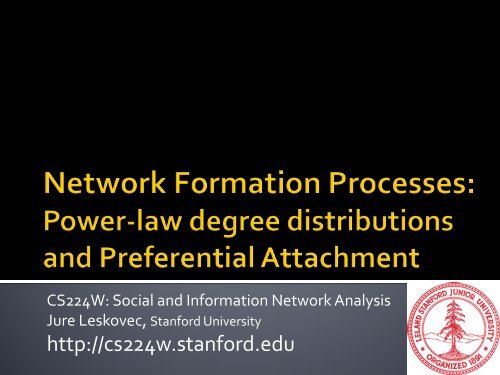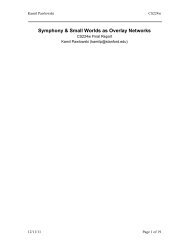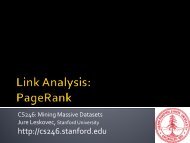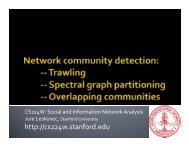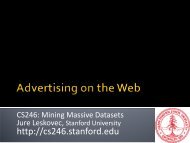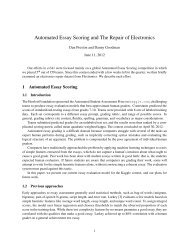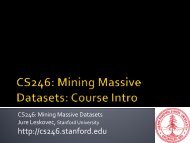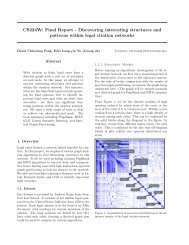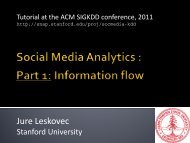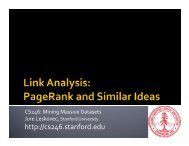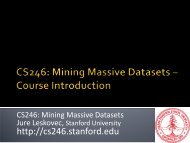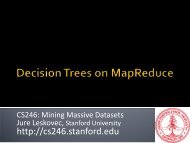Slides - SNAP - Stanford University
Slides - SNAP - Stanford University
Slides - SNAP - Stanford University
You also want an ePaper? Increase the reach of your titles
YUMPU automatically turns print PDFs into web optimized ePapers that Google loves.
CS224W: Social and Information Network Analysis<br />
Jure Leskovec, <strong>Stanford</strong> <strong>University</strong><br />
http://cs224w.stanford.edu
What do we observe that<br />
needs explaining<br />
Small-world model?<br />
Diameter<br />
Clustering coefficient<br />
Preferential Attachment:<br />
Node degree distribution<br />
What fraction of all nodes have degree k (as a function of k)?<br />
Prediction from simple random graph models:
Expected based on G np<br />
Found in data
Take a network, plot a histogram of P(k) vs. k<br />
Probability: P(k) = P(X=k)<br />
Plot: fraction of nodes<br />
with degree k:
Probability: P(k) = P(X=k)<br />
Plot the same data on log-log axis:<br />
Flickr social<br />
network<br />
n= 584,207,<br />
m=3,555,115
[Faloutsos, Faloutsos and Faloutsos, 1999]<br />
Internet domain topology<br />
11/1/2011 Jure Leskovec, <strong>Stanford</strong> CS224W: Social and Information Network Analysis, http://cs224w.stanford.edu 6
[Broder et al., 2000]<br />
11/1/2011 Jure Leskovec, <strong>Stanford</strong> CS224W: Social and Information Network Analysis, http://cs224w.stanford.edu 7
[Barabasi-Albert, 1999]<br />
Actor collaborations<br />
Web graph<br />
Power-grid<br />
11/1/2011 Jure Leskovec, <strong>Stanford</strong> CS224W: Social and Information Network Analysis, http://cs224w.stanford.edu 8
f(x)<br />
f ( x)<br />
=<br />
c<br />
1<br />
0.6<br />
0.2<br />
− x<br />
f ( x ) = cx<br />
f ( x)<br />
= cx<br />
20 40 60 80 100<br />
Above a certain x value, the power law is<br />
always higher than the exponential.<br />
−0.<br />
5<br />
11/1/2011 Jure Leskovec, <strong>Stanford</strong> CS224W: Social and Information Network Analysis, http://cs224w.stanford.edu 9<br />
x<br />
−1
Power-law vs. exponential on log-log<br />
and log-lin scales<br />
10 0<br />
10 0<br />
10 -1<br />
10 -2<br />
10 -3<br />
10<br />
-4<br />
log-log<br />
10 1<br />
f ( x ) = c<br />
− x<br />
10 2<br />
x … logarithmic<br />
y … logarithmic<br />
f ( x ) = cx<br />
−0.<br />
5<br />
f ( x ) = cx<br />
−1<br />
10 3<br />
semi-log<br />
[Clauset-Shalizi-Newman 2007]<br />
f ( x ) = c<br />
f ( x ) = cx<br />
11/1/2011 Jure Leskovec, <strong>Stanford</strong> CS224W: Social and Information Network Analysis, http://cs224w.stanford.edu 10<br />
− x<br />
x … linear<br />
y … logarithmic<br />
−0.<br />
5<br />
f ( x ) = cx<br />
−1
11/1/2011 Jure Leskovec, <strong>Stanford</strong> CS224W: Social and Information Network Analysis, http://cs224w.stanford.edu 11
Power-law degree exponent is<br />
typically 2 < α < 3<br />
Web graph:<br />
α in = 2.1, α out = 2.4 [Broder et al. 00]<br />
Autonomous systems:<br />
α = 2.4 [Faloutsos 3 , 99]<br />
Actor-collaborations:<br />
α = 2.3 [Barabasi-Albert 00]<br />
Citations to papers:<br />
α ≈ 3 [Redner 98]<br />
Online social networks:<br />
α ≈ 2 [Leskovec et al. 07]<br />
11/1/2011 Jure Leskovec, <strong>Stanford</strong> CS224W: Social and Information Network Analysis, http://cs224w.stanford.edu 12
Definition:<br />
Networks with a power law tail in<br />
their degree distribution are called<br />
“scale-free networks”<br />
Where does the name come from?<br />
Scale invariance: there is no characteristic scale<br />
Scale-free function:
In social systems – lots of power-laws:<br />
Pareto, 1897 – Wealth distribution<br />
Lotka 1926 – Scientific output<br />
Yule 1920s – Biological taxa and subtaxa<br />
Zipf 1940s – Word frequency<br />
Simon 1950s – City populations<br />
11/1/2011 Jure Leskovec, <strong>Stanford</strong> CS224W: Social and Information Network Analysis, http://cs224w.stanford.edu 14
Many other quantities follow heavy-tailed distributions<br />
[Clauset-Shalizi-Newman 2007]<br />
11/1/2011 Jure Leskovec, <strong>Stanford</strong> CS224W: Social and Information Network Analysis, http://cs224w.stanford.edu 15
[Chris Anderson, Wired, 2004]<br />
11/1/2011 Jure Leskovec, <strong>Stanford</strong> CS224W: Social and Information Network Analysis, http://cs224w.stanford.edu 16
CMU grad-students at<br />
the G20 meeting in<br />
Pittsburgh in Sept 2009<br />
11/1/2011 Jure Leskovec, <strong>Stanford</strong> CS224W: Social and Information Network Analysis, http://cs224w.stanford.edu 17
Degrees are heavily skewed:<br />
Distribution P(X>x) is heavy tailed if:
Various names, kinds and forms:<br />
Long tail, Heavy tail, Zipf’s law, Pareto’s law<br />
Heavy tailed distributions:<br />
P(x) is proportional to:<br />
[Clauset-Shalizi-Newman 2007]<br />
11/1/2011 Jure Leskovec, <strong>Stanford</strong> CS224W: Social and Information Network Analysis, http://cs224w.stanford.edu 20
What is the normalizing constant?<br />
P(x) = z x -α z=?
What’s the expectation of a power-law<br />
random variable x?<br />
∞
Power-laws: Infinite moments!<br />
If α ≤ 2 : E[x]= ∞<br />
If α ≤ 3 : Var[x]=∞
BAD!<br />
Estimating α from data:<br />
1. Fit a line on log-log axis using least squares<br />
method: min log
OK<br />
Estimating α from data:<br />
2. Plot Complementary CDF
OK<br />
Estimating α from data:<br />
3. Use MLE:
CCDF, Log<br />
scale, α=1.75<br />
Linear scale<br />
CCDF, Log<br />
scale, α=1.75,<br />
exp. cutoff<br />
Log scale,<br />
α=1.75<br />
11/1/2011 Jure Leskovec, <strong>Stanford</strong> CS224W: Social and Information Network Analysis, http://cs224w.stanford.edu 27
What is the expected maximum degree K<br />
in a scale-free network?<br />
The expected number of nodes with degree > K<br />
∞<br />
should be less than 1: ∫
Why don’t we see networks with exponents<br />
in the range of
Can not arise from sums of independent events<br />
Recall: in
Random network<br />
(Erdos-Renyi random graph)<br />
Degree distribution is Binomial<br />
11/1/2011<br />
Scale-free (power-law) network<br />
Degree<br />
distribution is<br />
Power-law<br />
Jure Leskovec, <strong>Stanford</strong> CS224W: Social and Information Network Analysis, http://cs224w.stanford.edu Part 1-31
Preferential attachment<br />
[Price ‘65, Albert-Barabasi ’99, Mitzenmacher ‘03]<br />
Nodes arrive in order 1,2,…,n<br />
At step j, let d i be the degree of node i < j<br />
A new node j arrives and creates m out-links<br />
Prob. of j linking to a previous node i is<br />
proportional to degree d i of node i<br />
P (<br />
j → i)<br />
=<br />
∑<br />
k<br />
d<br />
i<br />
d<br />
k<br />
11/1/2011 Jure Leskovec, <strong>Stanford</strong> CS224W: Social and Information Network Analysis, http://cs224w.stanford.edu 33
New nodes are more likely to link to nodes<br />
that already have high degree<br />
Herbert Simon’s result:<br />
Power-laws arise from “Rich get richer”<br />
(cumulative advantage)<br />
Examples [Price 65]:<br />
Citations: New citations to a paper are<br />
proportional to the number it already has<br />
11/1/2011 Jure Leskovec, <strong>Stanford</strong> CS224W: Social and Information Network Analysis, http://cs224w.stanford.edu 34
We will analyze the following model:<br />
Nodes arrive in order 1,2,3,…,n<br />
When node j is created it makes a<br />
single link to an earlier node i chosen:<br />
1)With prob. p, j links to i chosen uniformly at<br />
random (from among all earlier nodes)<br />
[Mitzenmacher, ‘03]<br />
2) With prob. 1-p, node j chooses node i uniformly<br />
at random and links to a node i points to.<br />
Note this is same as saying: With prob. 1-p, node j links<br />
to node u with prob. proportional to d u (the degree of u)<br />
11/1/2011 Jure Leskovec, <strong>Stanford</strong> CS224W: Social and Information Network Analysis, http://cs224w.stanford.edu 35
Claim: The described model generates<br />
networks where the fraction of nodes with<br />
degree k scales as:<br />
1<br />
−(<br />
1+<br />
)<br />
P(<br />
d = k)<br />
∝ k<br />
q<br />
i<br />
α<br />
=<br />
1<br />
+<br />
1<br />
where q=1-p<br />
11/1/2011 Jure Leskovec, <strong>Stanford</strong> CS224W: Social and Information Network Analysis, http://cs224w.stanford.edu 36<br />
1<br />
−<br />
p
Consider deterministic and continuous<br />
approximation to the degree of node i as a<br />
function of time t<br />
t is the number of nodes that have arrived so far<br />
Degree d i(t) of node i (i=1,2,…,n) is a continuous<br />
quantity and it grows deterministically as a<br />
function of time t<br />
Plan: Analyze d i(t) – continuous degree of<br />
node i at time t ≥ i<br />
11/1/2011 Jure Leskovec, <strong>Stanford</strong> CS224W: Social and Information Network Analysis, http://cs224w.stanford.edu 37
Plan: Analyze continuous degree d i(t) of<br />
node i at time t ≥ i<br />
Node i=t=5 comes and has degree of 1 to<br />
share with other nodes:<br />
i d i(t-1) d i(t)<br />
1 1 =1 +
Initial condition:<br />
d i(t)=0, when t=i (node i just arrived)<br />
Expected change of d i(t) over time:<br />
Node i gains an in-link at step t+1 only if a link<br />
from a newly created node t+1 points to it.<br />
What’s the probability of this event?<br />
With prob. p node t+1 links randomly:<br />
Links to our node i with prob. 1/t<br />
With prob. 1-p node t+1 links preferentially:<br />
Links to our node i with prob. d i(t)/t<br />
So: Prob. node t+1 links to i is:
d
What is the constant A?<br />
We know:
What is F(d) the fraction of nodes that has<br />
degree at least d at time t?<br />
How many nodes i have degree > t?
What is the fraction of nodes with degree<br />
exactly d?<br />
Take derivative of F(d):<br />
F<br />
'(<br />
d)<br />
=<br />
1<br />
p<br />
⎡<br />
⎢<br />
⎣<br />
q<br />
p<br />
d<br />
⎤<br />
+ 1⎥<br />
⎦<br />
1<br />
−1−<br />
q 1<br />
⇒ α<br />
= 1+<br />
q<br />
11/1/2011 Jure Leskovec, <strong>Stanford</strong> CS224W: Social and Information Network Analysis, http://cs224w.stanford.edu 43
Two changes from the G np<br />
model<br />
The network grows<br />
Preferential attachment<br />
Do we need both? Yes!<br />
Add growth to G np (assume p=1):<br />
x j = degree of node j at the end<br />
X j(u)= 1 if u links to j, else 0<br />
x j = x j(j+1)+x j(j+2)+…+x j(n)<br />
E[x j(u)] = P[u links to j]= 1/(u-1)<br />
E[x j] = ∑ 1/(u-1) = 1/j + 1/(j+1)+…+1/(n-1) = H n-1 – H j<br />
E[x j] = log(n-1) – log(j) = log((n-1)/j) NOT (n/j) α<br />
H n…n-th<br />
harmonic<br />
number:<br />
11/1/2011 Jure Leskovec, <strong>Stanford</strong> CS224W: Social and Information Network Analysis, http://cs224w.stanford.edu 44
Preferential attachment gives power-law<br />
degrees<br />
Intuitively reasonable process<br />
Can tune p to get the observed exponent<br />
On the web, P[node has degree d] ~ d -2.1<br />
2.1 = 1+1/(1-p) p ~ 0.1<br />
There are also other network formation<br />
mechanisms that generate scale-free networks:<br />
Random surfer model<br />
Forest Fire model<br />
11/1/2011 Jure Leskovec, <strong>Stanford</strong> CS224W: Social and Information Network Analysis, http://cs224w.stanford.edu 45
Copying mechanism (directed network)<br />
select a node and an edge of this node<br />
attach to the endpoint of this edge<br />
Walking on a network (directed network)<br />
the new node connects to a node, then to every<br />
first, second, … neighbor of this node<br />
Attaching to edges<br />
select an edge<br />
attach to both endpoints of this edge<br />
Node duplication<br />
duplicate a node with all its edges<br />
randomly prune edges of new node<br />
11/1/2011 Jure Leskovec, <strong>Stanford</strong> CS224W: Social and Information Network Analysis, http://cs224w.stanford.edu 46
Preferential attachment is not so good at<br />
predicting network structure<br />
Age-degree correlation<br />
Links among high degree nodes<br />
On the web nodes sometime avoid linking to each other<br />
Further questions:<br />
What is a reasonable probabilistic model for how<br />
people sample through web-pages and link to<br />
them?<br />
Short+Random walks<br />
Effect of search engines – reaching pages based on<br />
number of links to them<br />
11/1/2011 Jure Leskovec, <strong>Stanford</strong> CS224W: Social and Information Network Analysis, http://cs224w.stanford.edu 47
Preferential attachment is a key ingredient<br />
Extensions:<br />
Early nodes have advantage: node fitness<br />
Geometric preferential attachment<br />
Copying model:<br />
Picking a node proportional to<br />
the degree is same as picking<br />
an edge at random (pick node<br />
and then it’s neighbor)<br />
11/1/2011 Jure Leskovec, <strong>Stanford</strong> CS224W: Social and Information Network Analysis, http://cs224w.stanford.edu 48
We observe how the<br />
connectivity (length of<br />
the paths) of the network<br />
changes as the vertices<br />
get removed [Albert et al. 00;<br />
Palmer et al. 01]<br />
Vertices can be removed:<br />
Uniformly at random<br />
In order of decreasing<br />
degree<br />
It is important for<br />
epidemiology<br />
Removal of vertices<br />
corresponds to vaccination<br />
11/1/2011 Jure Leskovec, <strong>Stanford</strong> CS224W: Social and Information Network Analysis, http://cs224w.stanford.edu 49
Mean path length<br />
Real-world networks are resilient to random attacks<br />
One has to remove all web-pages of degree > 5 to disconnect the web<br />
But this is a very small percentage of web pages<br />
Random network has better resilience to targeted attacks<br />
Internet (Autonomous systems)<br />
Preferential<br />
removal<br />
Random<br />
removal<br />
Fraction of removed nodes<br />
Random network<br />
Fraction of removed nodes<br />
11/1/2011 Jure Leskovec, <strong>Stanford</strong> CS224W: Social and Information Network Analysis, http://cs224w.stanford.edu 50
Mean path length<br />
Real-world networks are resilient to random attacks<br />
One has to remove all web-pages of degree > 5 to disconnect the web<br />
But this is a very small percentage of web pages<br />
Random network has better resilience to targeted attacks<br />
Internet (Autonomous systems)<br />
Preferential<br />
removal<br />
Random<br />
removal<br />
Fraction of removed nodes<br />
Random network<br />
Fraction of removed nodes<br />
11/1/2011 Jure Leskovec, <strong>Stanford</strong> CS224W: Social and Information Network Analysis, http://cs224w.stanford.edu<br />
51


